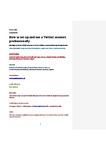How to set up and use a Twitter account professionally
| dc.contributor.author | Chudleigh, Meriel | |
| dc.contributor.author | Jones, Ray | |
| dc.date.accessioned | 2017-01-30T16:25:13Z | |
| dc.date.available | 2017-01-30T16:25:13Z | |
| dc.date.issued | 2016-11-02 | |
| dc.identifier.issn | 0029-6570 | |
| dc.identifier.issn | 2047-9018 | |
| dc.identifier.uri | http://hdl.handle.net/10026.1/8333 | |
| dc.description.abstract |
Rationale and key points This article encourages nurses to use Twitter to engage in professional discussions, share information and raise awareness of alternative views to enhance practice and patient care. Twitter is an online social media service that enables users to send and read 140-character messages called tweets. » Twitter is free and accessible across multiple platforms and devices, providing immediate contact with professionals, organisations and the public worldwide. » Many healthcare professionals use Twitter to share ideas and information. » Responsible use of Twitter creates opportunities to access information, discuss issues and challenge misconceptions to support professional nursing behaviours. Reflective activity 'How to' articles can help update your practice and ensure it remains evidence based. Apply this article to your practice. Reflect on and write a short account of: 1. How you could develop your use of Twitter for professional learning and interaction with healthcare professionals and others. 2. How you could support a colleague to use Twitter for the first time. | |
| dc.format.extent | 40-43 | |
| dc.format.medium | ||
| dc.language | en | |
| dc.language.iso | en | |
| dc.publisher | RCN Publishing Ltd. | |
| dc.subject | ||
| dc.subject | communication | |
| dc.subject | online discussion | |
| dc.subject | professional development | |
| dc.subject | social media | |
| dc.subject | Blogging | |
| dc.subject | Communication | |
| dc.subject | Humans | |
| dc.subject | Internet | |
| dc.subject | Interprofessional Relations | |
| dc.subject | Social Media | |
| dc.subject | United Kingdom | |
| dc.title | How to set up and use a Twitter account professionally | |
| dc.type | journal-article | |
| dc.type | Journal Article | |
| plymouth.author-url | https://www.ncbi.nlm.nih.gov/pubmed/27861058 | |
| plymouth.issue | 10 | |
| plymouth.volume | 31 | |
| plymouth.publication-status | Published | |
| plymouth.journal | Nursing Standard | |
| dc.identifier.doi | 10.7748/ns.2016.e10560 | |
| plymouth.organisational-group | /Plymouth | |
| plymouth.organisational-group | /Plymouth/Faculty of Health | |
| plymouth.organisational-group | /Plymouth/Faculty of Health/School of Nursing and Midwifery | |
| plymouth.organisational-group | /Plymouth/REF 2021 Researchers by UoA | |
| plymouth.organisational-group | /Plymouth/REF 2021 Researchers by UoA/UoA03 Allied Health Professions, Dentistry, Nursing and Pharmacy | |
| plymouth.organisational-group | /Plymouth/Research Groups | |
| plymouth.organisational-group | /Plymouth/Research Groups/Institute of Health and Community | |
| plymouth.organisational-group | /Plymouth/Users by role | |
| plymouth.organisational-group | /Plymouth/Users by role/Academics | |
| dc.publisher.place | England | |
| dcterms.dateAccepted | 2016-08-04 | |
| dc.rights.embargodate | 2017-11-2 | |
| dc.identifier.eissn | 2047-9018 | |
| dc.rights.embargoperiod | Not known | |
| rioxxterms.versionofrecord | 10.7748/ns.2016.e10560 | |
| rioxxterms.licenseref.uri | http://www.rioxx.net/licenses/all-rights-reserved | |
| rioxxterms.licenseref.startdate | 2016-11-02 | |
| rioxxterms.type | Journal Article/Review |


